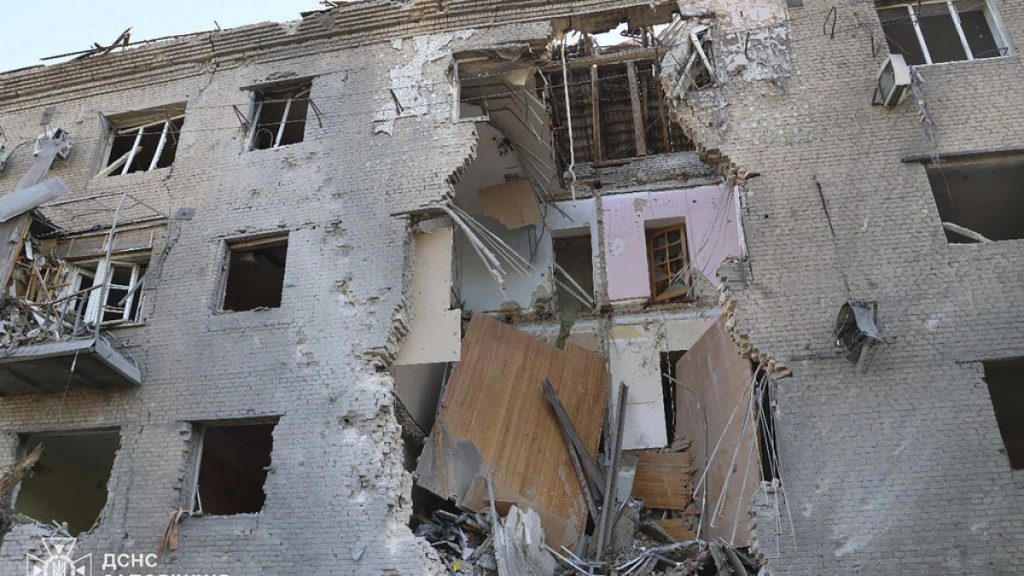At least 13 people were injured in Zaporizhzhia, Ukraine after Russia launched a series of guided bomb attacks overnight. The aerial bombs struck the city 13 times, causing massive damage including the destruction of a residential high-rise building and several private homes. Ivan Fedorov, head of the Zaporizhzhia regional military administration, reported that three districts in the city were affected and there may still be people trapped under the rubble. Zaporizhzhia is located near the front lines of the conflict and has been a target for Russian attacks due to its proximity to areas occupied by Moscow’s troops. In a separate incident in Sumy, Russia attacked a hospital twice, resulting in 10 deaths and 22 injuries. Most of the fatalities occurred during the second strike when emergency services and patients were present.
Russian forces shot down more than 100 Ukrainian drones over Russian territory, leading to significant damage and destruction in several regions. The Ministry of Defence in Russia reported that 125 drones were downed overnight across seven regions. The southwestern region of Volgograd was heavily targeted with 67 drones shot down by Russian air defenses. In Voronezh, falling debris damaged an apartment block and a private home, sparking a fire that resulted in flames rising from the top floor of a high-rise building. No casualties were reported in this incident. In the Rostov region, falling debris from 18 downed drones sparked a wildfire that spread over 20 hectares of forest. Emergency services were working to extinguish the blaze, which did not pose a threat to populated areas.
The attacks in Zaporizhzhia and Sumy mark the latest in a series of escalations between Russia and Ukraine since the invasion began in February 2022. The conflict has caused widespread devastation and casualties, leading to increased tensions between the two countries. Ukraine has been fighting back against Russian forces using drones and other military tactics to defend its territory and protect its people. Russia’s continued aggression and targeting of civilian areas have drawn international condemnation and calls for an immediate ceasefire to prevent further bloodshed and destruction.
The attacks on civilian infrastructure in Zaporizhzhia and Sumy have raised concerns about the safety and security of civilians in Ukraine. The deliberate targeting of hospitals and residential buildings by Russian forces has resulted in numerous casualties and widespread damage, further exacerbating the humanitarian crisis in the country. The international community has called for an end to the violence and for both sides to engage in diplomatic negotiations to find a peaceful resolution to the conflict. The heavy toll on civilians and the continued escalation of hostilities have underscored the urgent need for a ceasefire and a return to peaceful dialogue to prevent further loss of life and destruction.
The use of drones in the conflict between Russia and Ukraine has added a new dimension to the fighting, with both sides deploying unmanned aircraft for reconnaissance and attacks. The downing of more than 100 Ukrainian drones over Russian territory has highlighted the effectiveness of this technology in modern warfare. The destruction caused by falling debris from the downed drones underscores the risks involved in the use of such weapons in densely populated areas. The damage caused by the drones in Volgograd, Voronezh, and Rostov regions has raised concerns about the impact of the conflict on civilian populations in Russia and the need to protect innocent lives in the midst of the ongoing hostilities.
The wildfires sparked by falling debris from the downed drones in Russia have added to the environmental impact of the conflict between Russia and Ukraine. The destruction of forests and wildlife habitats in the Rostov region, in particular, has highlighted the ecological consequences of the fighting in the region. The efforts of emergency services to extinguish the fires and prevent further damage to the environment underscore the need for sustainable and responsible military actions to minimize the impact on the natural world. The international community must address the environmental fallout of the conflict and support efforts to protect the environment and promote sustainable development in the region.


